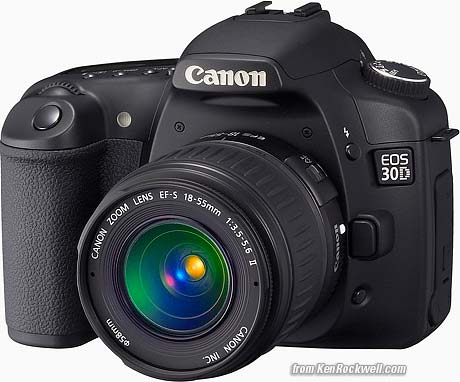Canon
30D
(2006-2008)
© 2006 KenRockwell.com
Red Hot Deal, September 2008: Adorama is giving away the Canon 30D, brand-new for $699, a screaming deal since they were over $1,000 when new in 2006.
The 30D is about 90% of the newest 50D, for a fraction of the price.
Plain-English 30D User's Guide
Camera LCD Monitor Comparisons, including 30D.
Memory Card and Download Speed Comparisons, including 30D
Nikon/Canon DSLR Noise and Resolution Shootout
INTRODUCTION
Specs Performance Recommendations
|
I personally buy from Adorama, Amazon, Ritz, B&H and J&R. I can't vouch for ads below.
|
The 30D was introduced in February 2006 to replace the Canon 20D.
Like all Canons, the colors and images look great. They are smooth, sharp and detailed, without being harsh.
Shoot with a 30D, and if you know what you're doing, you'll get fantastic results.
The 30D is a well made, lightweight and reasonably solid camera that's the fastest in its category. This category, as defined by me, is plastic DSLRs. The Nikon D200 is as fast, but it's at the bottom of the sealed metal pro camera category and is a lot heavier and more expensive.
I'd get a 30D or 20D if I did sports and this was my budget.
The 30D is the first choice of weekend pros and serious amateurs. Full-time pros use the 1D Mk II N, and people who just want the same great photos in a lighter, less expensive camera get the Digital Rebel XT. The new Digital Rebel XTi has more resolution than any of these, but not the ruggedness or speed of the other non-Rebels.
Sure, Canon and Nikon each make digital cameras selling for four times the price, but most pros use these when they have to pay for them out of their own pockets.
The 30D and 20D are much more solid and faster than Rebels, and have more controls and easier access to them.
The 30Dis almost identical to the 20D. If price matters, get a 20D. It's the same thing with a smaller screen!
The 30D adds over the 20D:
Bigger 2.5" LCD. Sadly, the one I borrowed had a nasty green cast to it, making it sort of useless for gauging color while shooting. The smaller LCD of the 20D I found to be much more accurate. This is what sparked my Camera LCD Monitor Comparison to see if I was imagining this or not. Sadly, the 30D I tested really was off-color. I haven't gotten any stick time with other samples to see if they are all this way.
Frame rates of both 5 FPS and 3 FPS. (20D only does 5 FPS.) I prefer 3 FPS for the still subjects I shoot. I set my cameras to 3FPS so one push is one shot, and holding it longer gives me several if I'm in low light and need several shots to ensure a sharp one. The 5FPS rate usually blows off a few frames even if I only wanted one.
Color RGB histogram, a huge improvement over the worse-than-useless black-and-white histogram of the 20D.
Color saturation adjustment goes to +4, twice as far as most cameras and the 20D, which only goes to +2.
Faster Data Download: twice as fast as the 20D. Details.
Spot Meter. I've never used this in any SLR camera.
Half an ounce (15g) heavier and 1/10" (2mm) deeper.
That's it. Everything else also applies from my Canon 20D review.
SPECIFICATIONS with commentary back to top
Specs Performance Recommendations
Lenses: Works perfectly with every EF and EF-S lens.
Viewfinder: adjustable, -3 to +1 Diopters.
Depth-of-Field Preview Button? Yes; works silently.
AF: 9 points.
AF Modes: Single (ONE SHOT), Continuous (AI SERVO), and Auto-switching (AI FOCUS, my favorite).
AF Assist Light: Not really: instead of an annoying beam, the 30D fires an ultra-annoying series of flash bursts. It doesn't work very well.
Metering: 35-zone Evaluative, Center-only (called partial by Canon), Center-weighted and spot.
Exposure Modes: Program, Manual, Shutter- and Aperture-priority and the weird depth-of-field mode (A-DEP), which I ignore.
Exposure Mode Selection: Dial on top left of camera.
Idiot Modes: Yes.
Frame Rate: 5 FPS, also 3 FPS.
Shutter: 1/8,000 to 30 seconds, Bulb.
Flash Sync: 1/250.
PC Flash Sync Terminal? Yes, up to 250V. Manual says it's OK to use the hot shoe and PC terminal at the same time
Remote Release: Expensive dedicated cords. No easy wireless control like the Rebels.
Built-in Flash? Yes, pop-up, rated GN 13m/43' at ISO 100.
Flash System: Wireless control, E-TTL II Autoflash, FP High Speed Sync. Flash Exposure Lock, Compensation and Bracketing. Designed for EX-Series flashes. Doesn't work well with older EZ, E, EG, ML or TL flashes; use them in Manual mode if at all. E-TTL-II adds distance info over E-TTL.
Mirror Lock-Up? Yes, hidden in Custom Function 12.
Sensor: 8MP, 1.6x crop/magnification factor (APS-C), 22.5 x 15.0mm, CMOS.
Image Sizes: 3,504 x 2,336 pixel native, also 2,544 x 1,696 and 1,728 x 1,152 pixels.
File Formats: JPG (2 levels of compression) and CR2 raw.
ISO: 100 - 1,600. ISO 3,200 available as "H" is you activate it in Custom Function 08.
White Balance: AUTO, Direct Sun, Cloudy, Shade, Tungsten, Fluorescent, Flash, Degrees Kelvin and Custom Manual (white or gray card).
White Balance Trim: Both warm/cool and green/magenta, but hidden in a menu.
Color Spaces: sRGB (use this, the default) and Adobe RGB (avoid this unless you really, really know what you're doing and do every step of printing yourself).
Image Tweaks: Saturation, Contrast, Sharpening and Hue Shift. Canon hides these by calling them "Picture Styles" in the shooting menu.
B/W Mode? Yes, and can simulate the use of a colored contrast filter (yellow, orange, red or green). You may also select toned print effects of Sepia, Blue, Purple or Green. I prefer to shoot color and convert later.
LCD Monitor: 2.5," 230,000 pixels.
Histograms: Monochrome and RGB Color.
GPS Input: none.
Digital Out: Standard tiny USB connector. It's the same as Canon point-and-shoots, Nikon DSLRs and my GPS. One cord taken along with my laptop talks to everything.
Made in: Japan.
Battery: BP-511A Lithium-ion. CR2016 for clock back-up.
Charger: CG-580 folding plug, universal worldwide: 100 - 240 V, 50 / 60 Hz (at least in USA. Other countries may get one with a removable cord.)
Size: 5.7 x 4.2 x 2.9" (144 x 106 x 74mm), rated.
Weight: 24.7 oz. (700g) stripped (no battery, card or strap), rated.
Users Manual: Downloadable here from Canon. See also my my own free, simple English Canon 30D User's Guide. If not, pick up the phone and call:
Free Live Tech Support: (800) OK-CANON in the USA.
PERFORMANCE back to top
Specs Performance Recommendations
see also Camera LCD Monitor Comparisons, including 30D.
Memory Card and Download Speed Comparisons, including 30D.
Nikon/Canon DSLR Noise and Resolution Shootout
Image Quality
Overall
Like all Canons, the colors and images look great. They are smooth, sharp and detailed, without being harsh.
Shoot with a 30D, and if you know what you're doing, you'll get fantastic results.
Exposure
Exposure is uniform. It's much better than my Nikon D80, but not as good (consistent) as my Nikon D200.
I usually set the 30D's exposure compensation to -1/3 to -2/3 in contrasty light outdoors. Otherwise 0 works fine. The images below are all at 0, except for one as marked. See what works for you. Most Canons are too light for my taste at default. You enable setting this with the power switch, and then use the Big Dial to adjust.
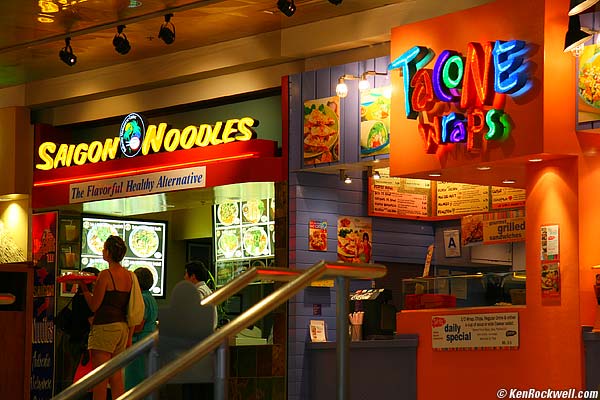
UTC Food Court, New La Jolla, California, September 2nd, 2006, 5:41PM.
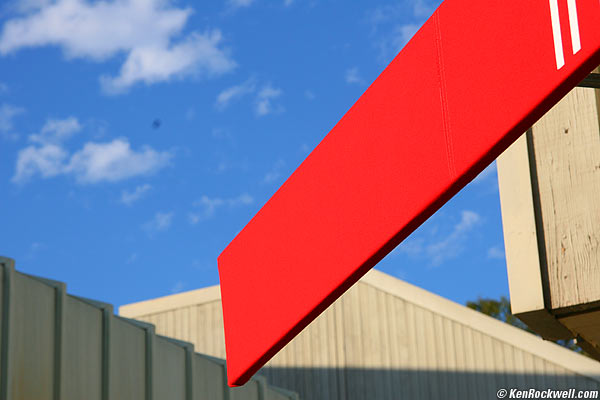
5:58 PM.
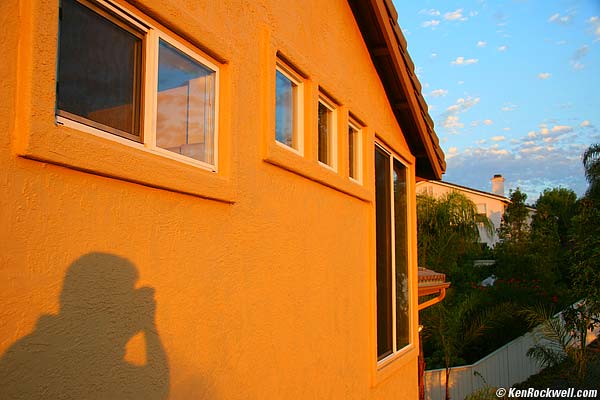
6:58 PM.
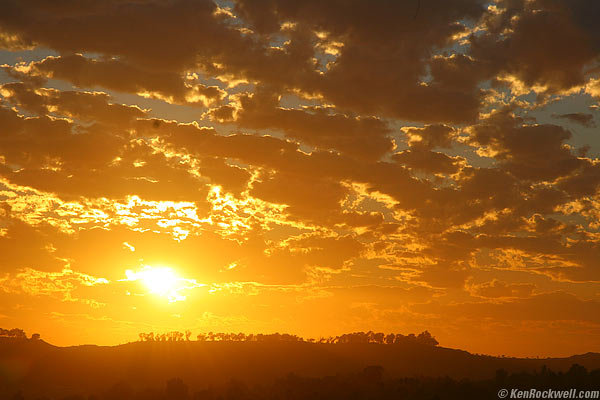
Sunset, Encinitas, California, September 2nd, 2006, 7:04PM. -1 compensation.
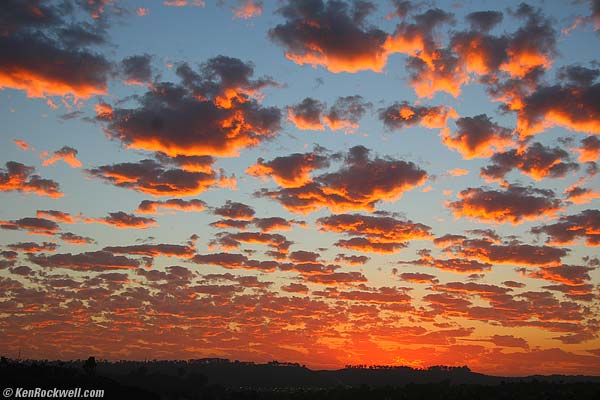
7:16 PM.
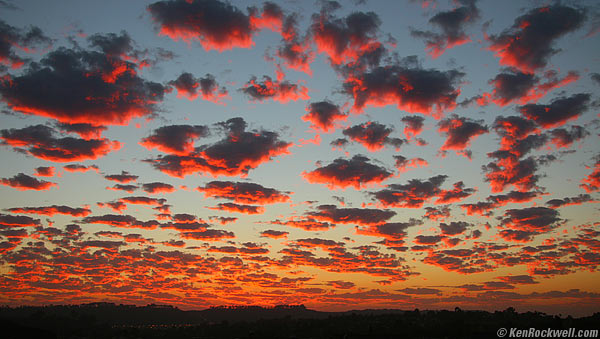
7:20 PM.
Colors look great! These snaps are exactly as they came from the 30D and were all snapped within less than two hours while running errands with the wife.
The 30D offers the unusual ability to crank saturation beyond (and below) most other cameras.
I prefer to have my color saturation (in the Picture Style menu) set to +2, the maximum, on all other Canons.
The 30D adjusts all the way to +4, which is a little wild even for me. The numbers correlate between 20D and 30D; the same amount + or - looks the same on each. The 20D goes from -2 to +2, the 30D goes from -4 to +4. +2 and -2 match between the 20D and 30D; the 30D has twice the range of adjustment.
Saturation +2 on Canon is the same as Saturation + and Color Mode III on my Nikons, so +4 saturation is twice as tweaked as my Nikons. FUN!
Here are example shots of a toten-ghetto-platz:
Saturation -4 |
Saturation -2 |
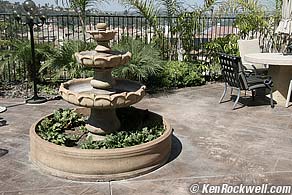 |
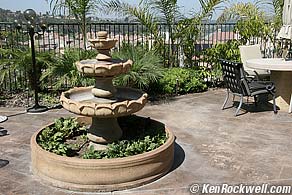 |
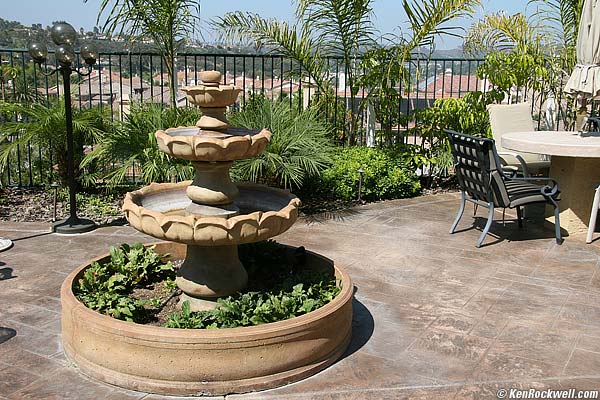
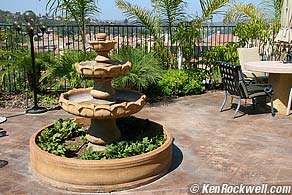 |
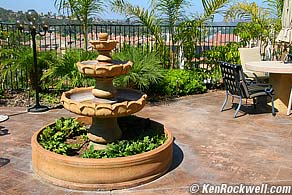 |
Saturation +2 |
Saturation +4 |
This example is a fairly dumpy, unsaturated subject. Note how at +4 it starts to sing and come alive. The 20D and my Nikons stop at +2 or its equivalent.
If you point your camera at 100% saturated things like flowers, the effects of saturation adjustments aren't as obvious. In this case, the +4 setting take dumpy and pumps it up, and -4 throws it back almost to B/W. Heck, for ghetto photography the -4 setting might be fun to accentuate the ghettophikashun (ghettofication) if I wasn't so into color.
You can set your SET button to let you get to these selections fast.
I set my three sets of "User Def." picture styles to +2, +3 and +4 saturation, and program my SET button to allow me to select among them quickly.
Ergonomics
Viewfinder
Like all the DSLRs from Nikon and Canon, it's sharp and bright and clear and adjusts easily for your eyesight.
The finder is a little smaller than the Nikon D200 and D80, and much bigger than the D70.
Exposure Mode Selection
Mode selection is by dial. There is no indication in the finder. You have to take your eye away from the finder to adjust it, unless you count clicks. When you do change the mode, the meter turns off until you tap the shutter button again.
Dial Functions
Which dials change aperture or shutter speed change with the exposure mode. This drives me crazy, since I expect to reach for the same dial to change aperture regardless of exposure mode. My Nikons do this correctly and ensure the same dial does the same thing regardless of exposure mode.
WB Adjustments
No direct fine-tuning. Fine tuning is only deep in a menu, and setting a custom manual white balance is even trickier. This is weird, since Canon pocket cameras make this easy, and the Canon XL-1 video camera has a dedicated button that does nothing but set manual WB.
The good news is that you also gave green/magenta fine tuning as well as warm/cold. Bad news is that this fine-tuning is global and applies to every setting, even Auto. You can't tune the WB presets individually. This fine-tune is more of a repair, calibration and service procedure than an option for achieving shot-to-shot perfection. Exact WB is critical to great photos, and tuning the WB is critical to getting the correct WB. The 30D's inability to provide easy fine-tuning adjustments to WB while shooting is my biggest complaint with the 30D. Canon doesn't seem to understand that WB is a creative tool we use to get great photos and not something we set once in a lab. This is great for use in a studio, but awful for outdoors and nature.
Kelvin color temp entry is in fixed 100K increments. This makes adjustment a little coarse at the coolest (2,800K) end and needlessly fine on the warm (10,000K) end. Must use a menu and remember to hit SET when done
Shots Remaining Indication
The good news is that it's clever enough to read fewer exposures if you set a higher ISO, because the noise at higher ISOs lead to larger files. It seems accurate, compared to Nikon's defectively conservatively defective readings.
The bad news is it can't read over 999. Nikons will read "2.7k" if you have 2,700 shots left.
I suspect this indicator is much more accurate than Nikon's are. Most Nikons underestimate by about 30%! The 30D seems accurate.
Help
No help information in menus. Sorry.
Canon USA has an excellent free live help line: (800) OK-CANON.
Strap Lugs
Strap lugs are slots. I prefer these over pro cameras which use tiny eyelets and split rings. I can attach a strap to the 30D directly and quickly without piddling with split rings, and there is less hardware between my strap and the camera to break.
Clock
Good news: The clock comes set from the factory. You get no "please set clock" menu the first time you turn it on.
Good news: it uses an easily replaceable CR2016 cell to keep the clock running. The clock runs whether or not you have a regular battery in the 30D.
Bad news: it comes set to to Japanese time (UTC + 8). That makes it 16 hours ahead of California. Be sure to reset it, since it won't ask you!
Autofocus
This is why all the sports pros swapped to Canon around 1990. AF is almost instantaneous with the good and cheap Canon 18-55mm lens, and instantaneous with the Canon 17-85mm lens.
It is always accurate, and so fast it would scare the innocent. It's faster than my eyes can change focus! AF speed depends more on the lens than differences between cameras (same with Nikon).
AF is Canon's strong point. If I was a sports shooter, I'm sure I'd be shooting Canon, too.
You can set the unnamed toggle switch to choose AF points directly (no need for the [+] button) with Custom Function 13.
Call me childish (I loved the documentary Borat), but I like the way the auto AF point selector works. You push the center of the selector to get all the AF points to light, then the 30D chooses which to use by magic. It works great for most things.
Mirror Lock-Up
MLU is hidden in custom menu 12.
Use the self timer, which automatically sets itself to 2 seconds. If not, you'll need a $50 RS-80N3 or $135 TC-80N3 release cord.
Flash
The built-in works great. It doesn't seem to have the flexibility of the Nikons (I couldn't find manual control and I couldn't figure out wireless flash, easy with Nikon, etc.), but for its intended purpose it works fine. This could also have been my own ignorance.
Canon hides many of the flash sync options inside other functions. For instance, the important Rear Curtain option is hidden in Custom Function 15, while even a Nikon D50 has its own flash sync button.
Slow sync isn't available in Program mode. I think you need to use one of the idiot modes or Manual to get it. This is too bad: I always shoot my Nikons in Program, and set the slowest flash shutter speed to about 1/30 or 1/15 to let in ambient light.
Tip: See How to Use the * Button to prevent people and pets from blinking with flash.
Playback and LCD
It's a pain to to zoom in: you have to hit the + button several times to get where you want. This is the same as the lower end Nikons, but much worse than the D200's magic smart zoom mode.
If it's beem more tha minute and the 30D has gone to sleep, you can't just hit the Play button. You have to tap the shutter to wake it up, and then hit Play.
The color LCD is dim by 2006 standards. Most people crank it up to maximum brightness in the menus, at which point it's as bright as other DSLRs.
My biggest concern with the 30D I used was that its LCD's white-point was a bit greenish-cyan. This made it impossible to use the LCD for color adjustments while shooting. The 20D's LCD is smaller, but its colors are fine.
I'm picky and see things others don't. Many Apple 15" Powerbooks from about 2003-2004 had this same problem, and no one noticed until I put two of them next to each other.
Playback is normal for Canons. It takes a moment to wake up the 30D if it has gone to sleep. It takes a little bit of card-reading to call up the 9-shot thumbnails. Good news is you can jump ahead and behind, but each time it has to read all the images to call up the thumbnails.
When scrolling quickly ahead and behind the images remain soft, until they are given a fraction of a second to come in sharply. Contrast this to the Casio point-and-shoots, which can scroll forward and back at 10FPS at full quality! Even using the Big Rear Dial, you can spin it faster than the 30D can jockey playback images. This bugs me.
I found a weird artifact: Shoot some star targets and zoom in. The image you see on the camera's LCD is a slightly lower resolution version of what you really have. Thus, don't make any final sharpness judgments in-camera. I have no idea why this is, it just is. My Nikons zoom in and show exactly what's in the image. Weird, but not a deal breaker.
Canon only has one page of tech data as you playback. This makes it faster to page through the various screens, but unlike Nikon, says less on its one page than Nikon does in taking four pages to show the same information (histograms, highlights, and two pages of text.) For instance, the 30D won't tell you the focal length used unless you play it back in a computer.
Top Control LCD Panel
The top LCD goes to sleep when the 30D does after a minute. You have to tap the shutter to wake it up to see your settings. The top LCD of the Rebel XT and my Nikons stay on to tell you everything, even when the camera is asleep (not off), and the Nikons can stay sleeping for a month this way.
The Illuminator is a nice orange. The illuminator button is invisible and hard to find in the dark. The illuminator button only works if the 30D is awake; tap the shutter if it's not.
Mechanics
The 30D is a reasonably lightweight camera for carrying around all day.
It's sturdier than a Nikon D50/70/80, but not as sold as a Nikon D200.
There's just hard plastic on the bottom, not rubber, if you like to brace it on things.
The 30D is a very precise and high-speed machine. It's as fast as the D200 and feels better built than the D80.
I found the flush rear power switch worse than Nikon's easy-rotating shutter-collar power switches.
The 30D's CF card door feels cheap; much cheaper than the solid doors on most of Canon's point-and-shoots.
Data
File Sizes
Large JPG: 3.6 MB (fine) or 1.8 MB (normal).
Medium JPG: 2.2 MB (Fine) or
1.1 MB (normal).
Small JPG: 1.2 MB (Fine) or 600 kib (normal).
CR2 (Raw): 8.7 MB.
Transfer Speed
Data transfer is fast. I threw my card reader out on the trash pile of history.
Data downloads to my Mac at 283 MB/ minute. See all the details and comparisons at my Memory Card and Download Speed Tests.
Formatting
Formatting requires a menu. You should format every time you put a card in any digital camera, and every time you disconnect the 30D from a computer.
Power
Leave the power switch on all the time. Only turn it off to prevent accidental operation when packed away.
When the top LCD turns off the 30D is in semi-lockdown mode. All the buttons are ignored, which saves the batteries from being drained by accidental pushes as you carry the 30D. You have to tap the shutter button (or the power switch) to wake up the 30D.
Battery
My 30D came with a BP-511A battery, marked 7.4V, 1390 mAh, Li-ion, made in Japan. Canon says the BP-511, BP-512 and BP-514 batteries also work fine.
If you keep spare batteries in your bag, their safety covers have a marking which allows you mark FULL or EMPTY depending on the direction in which you attach it.
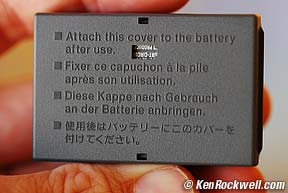 |
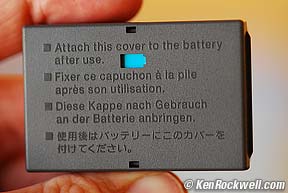 |
Cover used this way says "Empty" |
and used this way says "Full." |
Canon rates the battery good for 1,000 shots without flash, 700 with 50% flash. Canon says these are maximum and will be less if you use the LCD. I never ran one down, so I don't know.
Battery Meter
The battery meter has only three levels: full, almost empty and completely dead. This doesn't really count as a battery meter.
Battery Charger
Mine came with the CG-850, which has a folding integrated US power plug. It runs on 100 - 240V 50/60Hz worldwide. You only need to provide mechanical plug adapters as you travel, not voltage converters.
It's flashing light is clever enough to let you know the battery's charge level.
TRICK: The light glows solid at 90% charge. You should leave it on another hour to get to 100% charge.
The batteries seem to lose very little power while sitting idle, and the chargers are very smart. After a week idle, it recharged instantly.
High ISOs
The higher ISOs employ some noise filtering to reduce perceived noise. They also slightly soften texture.
The 30D looks fine at these high ISOs. It gets noisy, but at those high ISOs its acceptable. See my Nikon/Canon DSLR Noise and Resolution Shootout for explicit examples and comparisons.
RECOMMENDATIONS back to top
Specs Performance Recommendations
The 30D (or 20D) is what I'd have if I shot sports all the time and this was what fit my budget. Since the 20D is 95% the same camera for 80% of the price, consider it, too.
If you're in the Canon system, the 30D is the first choice of weekend pros and serious amateurs. Full-time pros use the 1D Mk II N, and people who just want the same great photos in a lighter, less expensive camera get the Digital Rebel XT. The new Digital Rebel XTi has more resolution than any of these, but not the ruggedness or speed of the other non-Rebels.
I prefer my Nikon D200, but that's just me, and it costs more.
Don't forget my simple English 30D Users Guide to learn all the tricks of how to use a 30D.
There is no protection for the LCD cover. If you scratch it you're stuck, unless you're bold enough to try amateur surgery as explained here to replace it.
TIP: Use generic PDA screen protectors from an office supply store to protect the screen on the back of the camera.
PLUG
I support my growing family through this website.
If you find this as helpful as a book you might have had to buy or a workshop you may have had to take, feel free to help me continue helping everyone.
If you've gotten your gear through one of my links or helped otherwise, you're family. It's great people like you who allow me to keep adding to this site full-time. Thanks!
If you haven't helped yet, please do, and consider helping me with a gift of $5.00.
It also helps me keep adding to this site when you get your goodies through these links to Adorama, Amazon, B&H, Ritz, and J&R. I use them and recommend them all personally.
Thanks for reading!
Ken

